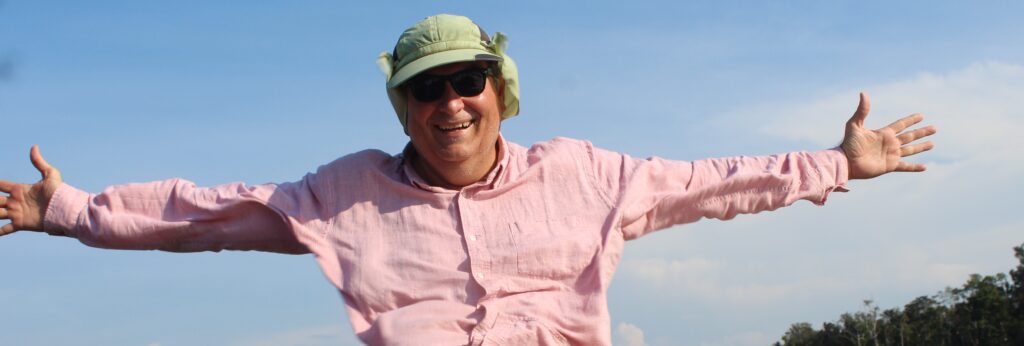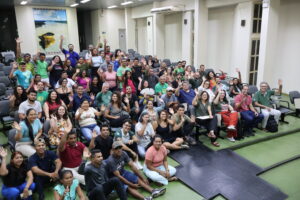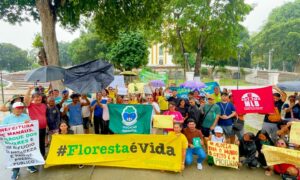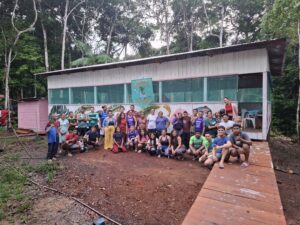By Clara Machado
Born in Belém and based in England, Carlos Peres has been studying, for the last 30 years, wildlife community ecology in Amazonian forests, the population ecology of key tropical forest resource populations, and biological criteria for designing large nature reserves. He currently co-directs four ecology and conservation research programs in Amazonian forests and has published around 400 articles on Neotropical forest ecology and conservation at scales of all sizes. Winner of international awards, the scientific director of Instituto Juruá is also a Professor in Tropical Conservation Ecology at University of East Anglia. Professor Dr. Carlos Peres gave us an interview to talk about his career in the mid-Juruá region of the Brazilian Amazon and how far he has come from his early primatology work in the area, plus details of a year-long expedition sailing the entire length of the Juruá River and his future expectations following the recent creation of Instituto Juruá.

INSTITUTO JURUÁ. What took you to the mid-Juruá region and what scenario did you find there?
CARLOS PERES. I was actually born and raised in the eastern Amazon, but the western Amazon has always been much more mysterious to me. I was around 24 years old, a PhD student at Cambridge University at the time and I was looking for a study area, interested in a very species rich primate community. By then, I heard that Petrobras has found oil and gas in the western Brazilian Amazon, so I decided to contact them asking if they could offer logistical support for my project in a really remote area. I was looking to work in a completely pristine forest that had never been worked by anybody else, and this is actually what I found. Petrobras would take me there by helicopter with a team of people who helped me to build a house and cut this massive trail system with 900 hectares. I had one of the largest trail systems of any tropical forest biologist that was basically created for that one study. I spent two years walking that trail system non-stop to do my PhD, getting all the supplies we needed every month in Carauari by helicopter. That’s how I got to know the Juruá to begin with, it was around 1987. In those days things were very different there, the literacy rates were very low and rural poverty was much higher. It was a bit of a baseline to which we can contrast all the changes in the Juruá both in terms of the demographics of the key resource populations but also the status of the local communities.
INSTITUTO JURUÁ. Can you tell us a little about the trajectory from your arrival in the mid-Juruá to the construction of Projeto Médio Juruá (PMJ)?
CARLOS PERES. I worked in a lot of other places in the Amazon but I have always meant to go back to the Juruá. So in 1991 we deployed a one-year fluvial expedition that covered the whole length of the Juruá River within Brazil twice, from the mouth of the Juruá on the Solimões, all the way to the Peruvian border and back. We bought this boat, called the Coró-coró, in Manaus and we adapted it as a research vessel. We were a core team of about 6 people, mainly taxonomists, and that was a huge adventure. That was the very first time a major white water tributary in the Amazon was travelled by a bunch of biologists. After that, I kept going back to Carauari every now and then until there was a chance to secure some funding from Darwin Initiative for the Survival of Species, and we deployed an Applied Ecology Research Program mostly looking at terrestrial resources. That was the first phase of PMJ, which was followed by the second phase, focused on floodplain and aquatic resources. There were also other initiatives in the region by the time. Instituto Juruá is a natural extension of everything else that we have been doing there.
INSTITUTO JURUÁ. How did conservation work with local communities develop over time?
CARLOS PERES. In that boat trip in 1991, we were arriving in some areas where we went up the river bank and people were then really poor. There was so little contact with outsiders in those days and hardly a boat ever went by. We saw that first hand in many of these really remote localities along the Juruá River. So things have changed quite a bit, and the political leaders along the Juruá have played a huge part in consolidating the Extractive Reserve Movement initiated in Acre, with Chico Mendes and others rubber workers at the time. Since then, the local people that we worked with were all predisposed to this conservation discourse. I don’t think it has been particularly difficult to convince them to embark on all of these ideas, maybe because they experienced a huge amount of hardship through their history. In a condition analogous to slavery, they owned debts to the guy who claimed to be the “baron” of the rubber state. The reserves, above all other things, ensured the economic emancipation of these people from the rubber barons, who dominated, since 1894, the whole trade of resources: fishes, manatees, turtles, rubber, everything that the forest could produce. If people tried to leave, they would get shot or tortured. When people in the Juruá hear their grandparents talking, that’s the story that they hear about and I hope the history doesn’t get wiped out completely from the memory of the new generation. They should know how tough things were even going back only about three or four decades. After extractive reserves came to be created, the social and political dynamics in these rural areas began to change and our project was built on the back of all of these transitions. If you talk to a ten-year-old child in the Juruá now, chances are that this child is already literate. There is a huge progress in socio economics indicators that also translate into health gains and income generation.
INSTITUTO JURUÁ. Can you tell us a bit more about how the conservation work is developed there?
CARLOS PERES. The Juruá is now showcasing a number of really interesting experiences and it’s also on the back of relatively intact ecosystems which basically helps everything else that we are doing. Essentially, what we are helping to create in the Juruá is a landscape where harvesting is spatially structured. You basically have no-take beaches and no-take lakes. It doesn’t matter if you do that for one or two species, all other species will benefit from this protection. The regulations are locally enforced by the nearest communities – they are very effective and inexpensive. I looked through the literature and I cannot think of another project that is better value for money in terms of what we are expanding financially and what we are getting back with conservation dividends. It’s incredibly effective because if you combine the high productivity of floodplain systems and very low harvesting, you get very high population growth. And I think there is a lot more to come as some programs become further consolidated.
INSTITUTO JURUÁ. How exceptional is the mid-Juruá region?
CARLOS PERES. In tropical conservation all over the world it’s relatively easy to win hearts and minds from local people if you have tangible benefits that revert back to them. However, the problem with conservation in most of the world is that conservation dividends rarely return to local people. These cases of win-win conservation like we do in the Juruá are rare. The Juruá is not a rule, but the exception. It’s an exceptional case of win-win mainly because most of our people are quite prepared to work very hard for conservation and sometimes even put their lives on the line because they are getting something out of it. The pirarucu (Arapaima gigas) is a really good example because you get this annual windfall that is still unprecedented in many of these communities. That’s why the communities that are already in the program are happy to be in, and the news of social economic benefits spread like wildfire, and there is a huge appetite for the uptake of the program, even in unprotected areas. The benefits that we see now in terms of the population recovery trajectories of the historically overexploited species (not just arapaima, but also manatee, river dolphins, large turtles) is just an incidental product of that recovery. People are no longer harvesting these species, so chances are they will recover numerically and they will start spreading. There is a spatial component of the population recovery and also a numerical component. I’m sure that, given time, all of these populations will recover fully and reach some sort of demographic equilibrium.
INSTITUTO JURUÁ. What are your personal expectations for Instituto Juruá, after all the succession of projects and partnerships that were made?
CARLOS PERES. I’m over the moon about the Instituto Juruá. We thought about this for many years, but I think the ingredients to get this in place were not really available until recently. The vast majority of municipal counties in the Brazilian Amazon either make money from timber, bovine beef or grains, like soybeans and maize. It’s interesting that the main revenue from Carauari is actually fish, a natural resource that can be perfectly renewable and sustainable, way more than timber. Also, fish from the river are far superior than captive bred fish, in terms of health, nutritional composition and taste. That’s the way that I think we are going forward, basically teaching consumers that if they pay a little bit more for a fish from the Juruá, they are getting a much better value of this resource. We are still producing a very valuable commodity which local people sell for very low prices for the time, but I think that will change over time.
INSTITUTO JURUÁ. In the current Brazilian political scenario is it possible to be optimistic about the development of the Amazon?
CARLOS PERES. It’s incredibly hard to be optimistic about the Amazon because much of the Amazon news tends to be about deforestation, fire and forest degradation, particularly under this hostile political climate. So I think that a region like the Juruá, given the good news that we are having from them, is a rare glimpse of a happy story. The biggest problem in the Amazon is that we still don’t know how to value natural resources, the standing forest, rivers and floodplain resources particularly well. These resources cannot compete with replacing the whole ecosystem with exotic pasture or soybean monoculture, as has been done by people from south and central parts of Brazil in the Amazon. Agribusiness tends to dominate Brazilian politics now and there is very little grassroots development going forward. So the Juruá is a rare glimpse of hope in a very glum scenario that we are going through these days.
INSTITUTO JURUÁ. What cultural recommendation can you give us to read, watch or listen to about the Amazon?
CARLOS PERES. The literary history of the Amazon begins with Alfred Russel Wallace and Henry Bates, so I recommend what I consider to be their basic literature: “The Naturalist on the River Amazons” (Henry Walter Bates) and “A Narrative of Travels on the Amazon and Rio Negro: With an Account of the Native Tribes, and Observations on the Climate, Geology and Natural History of the Amazon Valley” (Alfred Russel Wallace).






